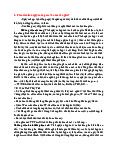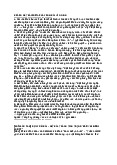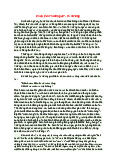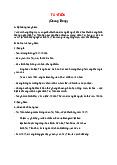












Preview text:
lOMoAR cPSD| 36133485
APTER 1: COUNTRY AND PEOPLE
1. Why is it said that “Britain doesn't have a climate, it only has weather”? / Why
does Britain’s climate have bad reputation?
This is due to its changeability. It may not rain very much altogether, but you can never be
sure of a dry day; there can be cool (even cold) days in July and some quite warm days in January.
2. What are the four nations and their capital cities on the British Isles?
England(London), Scotland(Edinburgh), Wales(Cardiff) and Northern Ireland(Belfast).
3. Which two large islands do the British Isles geographically consist of? Ireland, Great Britain
4. Which two political states do the British Isles consist of?
The Republic of Ireland. And The United Kingdom of Great Britain and Northern Ireland
5. Give some examples to prove the dominance of England.
For example, the supply of money in Britain is controlled by the Bank of England (there is no
such thing as a 'Bank of Britain'). The present queen of the country is universally known as
'Elizabeth the Second', even though Scotland and Northern Ireland have never had an
'Elizabeth the First'! (Elizabeth I of England and Wales ruled from 1553 to 1603.)
6. Introduce general geographical features of the UK.
Lying off the north-west coast of Europe, there are two large islands and several much
smaller ones. Collectively, they are known as The British Isles. The largest island is called
Great Britain. The other large one is called Ireland.
7. Describe the general information about the US.
The United States of America is a federal republic on the continent of North America. It was
an area of 9,629,047 sq km (3,717,796 sq mi) and it is the third largest country in the world
after Russia and Canada. The estimated U.S. population of 325 million people, ranked third
in the world behind China and India.
The United States consists of 50 states (including 48 contiguous states and the noncontiguous
states of Alaska and Hawaii). In addition, the United States includes a number of outlying
areas, such as the commonwealth of Puerto Rico and the Virgin Islands of the United States,
which are located on the Caribbean Sea, and the islands of America Samoa and Guam,
located in the Pacific Ocean.
The national capital is Washington, D.C., located along the bank of the Potomac River
between the states of Maryland and Virginia.
8. What are features of the climate in the US / Identify the diversification in the climate in the US. lOMoAR cPSD| 36133485
The overall climate in the United States of America is temperate, with notable
exceptions. Alaska has an Arctic tundra climate, while Hawaii and South Florida have
a tropical climate. The Great Plains are dry, flat and grassy, turning into arid desert in the far West.
9. What is different between the two theories “Melting Pot” and “Salad Bowl”
concerning about the American society?
Melting pot: a place where a variety of races, cultures, or individuals assimilate into a cohesive whole
Salad bowl: a metaphor for the way a multicultural society can integrate different
cultures while maintaining their separate identities
->Melting pot implies that everyone come to America and slowly become American.
They kind of melt together. But a salad bowl, those who come to America may adopt
some aspects of American culture but at the same time, they keep something that are
uniquely their cultures. For example, Vietnamese people come to the US and
participate in American political process, join American schools, and celebrate some
American holidays like Thanksgiving. But at the same time, they retain what means to be Vietnamese.
10. Why do American value Freedom and Self-reliance?
By freedom, Americans mean the desire and the right of all individuals to control their
own destiny without outside interference from the government, a ruling noble class,
the church, or any other organized authority. The desire to be free of controls was a
basic value of the new nation in 1776, and it has continued to attract immigrants to this country.
There is, however, a price to be paid for this individual freedom: self-reliance.
Individuals must learn to rely on themselves or risk losing freedom. Traditionally, this
means achieving both financial and emotional independence from their parents as
early as possible, usually by age eighteen or twenty-one. It means that Americans
believe they should take care of themselves, solve their own problems, and "stand on their own two feet”.
11. Introduce general information about Australia
- Australia’s official name is the Commonwealth of Australia
- Australia is the world's smallest continent, largest island and the only continent made up of a single country.
- Australia is located between the Indian and the Pacific Oceans. Its nearest neighbors are
the countries of Indonesia, Timor Leste (East Timor) and Papua New Guinea. lOMoAR cPSD| 36133485
- Australia is the sixth largest country in the world in terms of land mass at 2.97 million square miles.
- Australia has 6 States and 2 territories. The capital of Australia is Canberra
12. What are features of the climate in Australia?
Australia's climate varies greatly due to its vast size. Generally, it is warmer and drier than
the United States. Most of the continent receives only five to 20 inches of rain per year. About
one third of it is desert receiving less than 10 inches of rain a year, another third is arid (less
than 20 inches of rain a year) and the most reliable rainfall occurs on the east coast along the
Great Dividing Range and in the southwest corner of Western Australia. Parts of the
northeast (Queensland), which include the tropical rainforests, have seasonal rains of up to
60 inches per year as does the west coast of Tasmania in the south. The northern third of the
country is tropical (lying above the tropic of Capricorn) and the northern-most parts have a monsoon season.
13. Describe some largest cities in Australia
Sydney is Australia’s largest and most popular city. The Sydney Opera House and the
Sydney Bridge are its most iconic landmarks. Sydney beaches are also some of the
best and easiest destinations to visit. The largest city in Australia has plenty of other
attractions, too. Hyde Park, for example, is a popular place for locals and visitors
alike to visit when they seek to escape the summer heat. And the incredible Macquarie
Street is one of the most important commissioned streets in the world. It looks as
though it has no visible defects as every house, building, and patch of green grass is in top condition.
Melbourne is Australia’s second-largest city with a population of just over 4 million.
Many people come to Melbourne on Ocean Road. This road looks as good if not better
than it sounds. It’s simply one of the most spectacular in the country. Melbourne
Museum and the nearby South Melbourne Market are excellent stops for tourists as
well. Thousands of tourists stop here every year. But if you like a fancy shopping
experience, you can also stop at Queen Victoria Market.
Canberra is one of Australia’s largest cities and is also the capital of the country.
Many would have expected the capital to be Sydney or Melbourne, but this city is the
perfect compromise between the two as it sits right between them. You can visit
Canberra if you’re interested in making the most of visiting official government
buildings. This means you can check out the New Parliament House or the Museum of
Australian Democracy here. You can also visit the country’s National Museum to
learn more about Australia through its well-kept exhibits. Reference lOMoAR cPSD| 36133485
1/ Which state has the biggest land area in Australia? Western Australia
2/ Introduce some geographical features of Vietnam.
Located in Southeast Asia on the east side of Indochina Peninsula, and bordered by Laos and
Cambodia to west, China to the north, the Gulf of Thailand to the south. the Gulf of Tonkin
and the South China Sea to the east, Vietnam is long and thin, with an area of 331,210 square
kilometers (310,070 square kilometers land; 21,140 square kilometers water; 127,330 square
miles), which is slightly larger than New Mexico. Vietnam shares land boundaries with
Cambodia (1,228 kilometers), China (1,281 kilometers), and Laos (2,130 kilometers) for a
total of 4,639 kilometers. Vietnam’s coastline along the Gulf of Tonkin, the South China Sea,
and the Gulf of Thailand measures 3,444 kilometers (excluding islands). The Vietnamese refer
to the South China Sea as the East Sea.
3/ What are national holidays in Vietnam?
Lunar New Year, Independence Day, Hung Kings Commemorations, International Workers' Day...
4/ Who is the Prime minister in Australia now? Scott Morrison
5/ What is the climate in Vietnam?
Vietnam has a tropical monsoon climate with high humidity but its varied terrain means the
temperature and seasons will vary across the different regions:
- In Northern Vietnam, winter (November to April) is cool and dry and summer (May to
October) is hot, humid, and rainy (July to September has the highest rainfall).
- Central Vietnam is hot and dry in the summer (January to August) and cool and rainy in
winter, with monsoon-level rains in October and November.
- Southern Vietnam has constant warm temperatures. Here the seasons are simple: rainy
(May to November) and dry (November to May).
6/ Describe the education system in Vietnam.
There are 3 levels of education in the formal school system in Vietnam: Pre-school, Primary
education, Secondary education. The Secondary education consists lower secondary
education and upper secondary education. Primary and lower secondary education are
compulsory in Vietnam. Children start going to primary school at the age of 6 and after 5
years they move to lower secondary school where they study for 4 years. The upper secondary
education lasts 3 years, from the age of 15 to 17. In order to study at a university, students
have to pass the national examination held in early June every year for the GCSE. The
academic year is divided into 2 terms. It lasts 9 months from September 5th to the end of May.
The first term is from September to December and the second term lasts from January to May.
Students have a 3-month-summer holiday after the second term. lOMoAR cPSD| 36133485 THE HISTORY
1/ What is Stonehenge mysterious? And what is its meaning to British today?
Stonehenge was built on Salisbury Plain some time between 3050 and 2300 BC. One of its
mysteries is how it was ever built at all with the technology of the time (the stones come from
over 200 miles away in Wales). Another is its purpose. It appears to function as a kind of
astronomical clock and we know it was used by the Druids for ceremonies marking the passing of the seasons
In 2016 Stonehenge celebrated its 30th year as a World Heritage site – in 1986, together with
Avebury, it was one of the very first sites in the UK to be inscribed on the UNESCO World
Heritage List. Stonehenge have a special importance for anyone interested in the cultural
and religious practices of prehistoric Britain.
2/ What is Magna Carta and its significance to British history?
Magna Carta (Latin - Great Charter), document sealed by King John of England on June 15,
1215, in which he made a series of promises to his subjects that he would govern England
and deal with his vassals according to the customs of feudal law. Over the course of
centuries, these promises have required governments in England (and in countries influenced
by English tradition) to follow the law in dealing with their citizens.
The Magna Carta is one of the most important legal documents in the history of democracy. It
was a start of change from the feudal system to a more democratic system, by having the
people demand certain rights.
3/ What are the factors leading to the Industrial Revolution?
The increased trade which resulted from the links with these new markets
The many technical innovations in the areas of manufacturing and transport during this period
4/ Give examples to prove that “the first 20 years of the 20th century was a period of
extremism in Britain”?
- The Suffragettes, women demanding the right to vote, were prepared both to damage
property and to die for their beliefs
- The problem of Ulster in the north of Ireland led to a situation in which some sections of the
army appeared ready to disobey the government
- The government's introduction of new types and levels of taxation was opposed so
absolutely by the House of Lords
* Define the meanings of “Parliament” at first used and nowadays.
The word 'parliament', which comes from the French word parler (to speak), was lOMoAR cPSD| 36133485
first used in England in the thirteenth century to describe an assembly of nobles called
together by the king. In 1295, the Model Parliament set the pattern for the future by including
elected representatives from urban and rural areas.
Nowadays, in some countries, “Parliament” is the group of (usually) elected politicians or
other people who make the laws for their country
** What is Suffragettes?
Is women advocate of the right of women to vote, especially one who participated in protests
in the United Kingdom in the early 20th century. lOMoAR cPSD| 36133485 POLITICAL SYSTEM
1. Explain the meaning of the terms “constitutional monarchy” and “parliamentary democracy”
Constitutional monarchy means it is a country governed by a king or queen who accepts the advice of a parliament.
Parliamentary democracy is a country whose government is controlled by a parliament which
has been elected by the people.
2. Why is it said “Britain doesn’t have a written constitution?
The UK constitution is largely written, but in different documents.
It has never been codified into a single document. It is found in leading statutes,
conventions, judicial decisions and treaties.
Parliamentary sovereignty-the ultimate law-making power vested in the UK
parliament to create or abolish any law-is commonly regarded as the defining
principle of the British constitution.
3. Give examples to prove “the absolute power” of the Queen?
-She can choose anybody she likes to run the government for her.
-There are no restrictions on whom she picks as her Prime Minister. It does not have to be
somebody who has been elected.
-The same is true for her choices of people to fill some hundred or so other ministerial
positions. And if she gets fed up with her ministers, she can just dismiss them.
-Officially speaking, they are all 'servants of the Crown' (not servants of anything like 'the
country' or 'the people').
-She also appears to have great power over Parliament. It is she who summons a Parliament,
and she who dissolves it before a general election.
4. Explain the role of the Queen in appearance and in reality.
5. Who are the people in the cabinet? What are the functions of the cabinet?
Includes about 20 members (minister, heads of GOV departments, members of Parliaments (MPs)) *The Cabinet office:
-running a busy communication network
-keeping ministers in touch with each other
-drawing up the agendas for cabinet meetings
*The cabinet committees: lOMoAR cPSD| 36133485
-not necessarily politicians
-appointed by the Cabinet
-look into various matters in more detail
6. What is the role of the British Prime Minister?
-Chief executive of the GOV
-Leader of the party (holding the mot seats in the House of Commons)
-Presides over the Cabinet and selects Cabinet members
7. How are the seats arranged in the House of Commons?
8. Describe the four unique features of House of Commons in the UK.
- The seating arrangement
- No 'front', no obvious place for the Commons MPs simply stand up and speak from
wherever they happen to be sitting.
- No desks for the MPs → physically drift in and out of the room.
- The House is small, less than 400 seats → not enough room for over 650 MPs
(sometimes "imaginary" seats)
9. Who are in the U.K cabinet?
Includes about 20 members (minister, heads of GOV departments, members of Parliaments (MPs))
10. What are the functions of the U.S political branches? * Legislative Branch
- function → to make laws
- made up of representatives elected to Congress.
- Congress = the House of Representatives(435 Representatives) + the Senate(100 Senators) * Executive Branch
→ administering the laws, passed by Congress. * The President • Vice president • Cabinet * Judicial Branch:
determine whether laws of Congress or actions of the president violate the Constitution.
11. Who are in the US cabinet?
The heads of the 15 executive departments
12. What is Checks and Balances in the U.S government? lOMoAR cPSD| 36133485
The division of government power among three separate but equal branches provides for a
system of checks and balances. Each branch checks or limits the power of the other branches.
-The Supreme Court can overturn laws passed by Congress and signed by the president.
-The selection of federal and Supreme Court judges is made by the other two branches.
-The president appoints judges, but the Senate reviews his candidates and has the power to reject his choices.
->With this system of checks and balances, no branch of government has superior power.
13. Role of the Prime Minister in Australia’s government
KEY SPOKESPERSON FOR AUSTRALIA HEAD OF CABINET
LEADER OF THE GOVERNMENT MOST SENIOR MINISTER
14. What are the powers of the US President?
-As chief executive, the president appoints secretaries of the major departments that make up
the president’s cabinet.
-As head of state, the president represents the country abroad, entertains foreign leaders, and addresses the public.
-As director of foreign policy, he appoints foreign ambassadors and makes treaties with other nations.
-The president also serves as commander-in-chief of the armed forces and as head of his political party
15. How many branches are there in the U.S policy?
3 branches: Legislative Branch, Executive Branch, Judicial Branch
16. Why is there the division of power among the three branches of government?
The division of government power among three separate but equal branches provides for a
system of checks and balances. Each branch checks or limits the power of the other branches.
With this system of checks and balances, no branch of government has superior power
17. Describe the policy system in Australia lOMoAR cPSD| 36133485
18. Who is the Prime Minister in Australia’s government? what are his powers?
Scott Morrison is the Prime Minister in Australia’s government
KEY SPOKESPERSON FOR AUSTRALIA HEAD OF CABINET
LEADER OF THE GOVERNMENT MOST SENIOR MINISTER THE EDUCATION
1. Give examples to prove the lack of uniformity of education in Britain.
Explain a characteristic of uniformity of the British education.
2. Describe the three types of schools in Britain.
5. What is grammar school? Secondary modern school? Comprehensive school?
- A grammar school: students were taught academic subjects to prepare them for university,
the professions, managerial jobs o other highly-skilled jobs;
- A secondary modern school: students receive training in a wide range of simple, practical
skills→to focus on training in basic subjects, including mechanical skills (woodworking) and
domestic skills (cookery). Now, most children all go on to the same local school.
- A comprehensive school: children of all backgrounds and abilities would be educated in a
single school OR select its intake not on the basis of academic achievement or aptitude or the
wealth of the parents of the children it accepts.
3. What is the Methods of teaching at different levels in British education? lOMoAR cPSD| 36133485
4. What are SATs, Eleven Plus and CE examination?
- SATs (Standard Assessment Tests) is a national system of tests, which are taken at the ages of 6, 10 and 13.
- Eleven Plus which is used to sort pupils into different types of school at 11, typically
Grammar schools for the more academic and Secondary schools.
- The Common entrance normally taken at age 13 which is used as an entrance examination
for entry to Public/Independent school
6. What are the main features of the US education system?
7. Describe school attendance in the US.
8. Describe the education system in Australia.
9. Describe a typical school day in Australia. lOMoAR cPSD| 36133485 CHAPTER 5. THE ECONOMY
1. Describe the major sectors of British economy.
- The service sector dominates the UK economy, contributing around 78% of GDP
- The financial services industry is particularly important and London is the world's largest
financial centre (tied with New York).
- The British aerospace industry is the second- or third-largest national aerospace industry
depending on the method of measurement.
- The pharmaceutical industry plays an important role in the economy and the UK has the
third-highest share of global pharmaceutical R&D.
- The automotive industry is also a major employer and exporter.
- The British economy is boosted by North Sea oil and gas production; its reserves were
valued at an estimated £120 billion in 2011.
2. What are the main ways people in Britain look for work?
There are three main ways in which people look for work in Britain:
- Through newspapers (national ones for the highest-qualified, otherwise local ones)
- Through the local job centre
- Through privately-run employment agencies (which take a commission from employers).
3. What are the main work organizations in Britain?
- The organization which represents employers in private industry is called the Confederation
of British Industry (CBI)
- The Trades Union Congress (TUC) is a voluntary association of the country's trade unions,
representing employees in all types of business.
- National Union of Farmers (NUF), made up mostly of agricultural employers and
independent farmers. Considering the small number of people involved in agriculture in Britain
4. Who are the interest groups in American economy?
5. What are the features in Australian economic system?
6. How is the American economy described?
7. What is the role of the U.S government in economy?
8. Identify the role of Labor unions in the U.S.
CHAPTER 6. FESTIVALS AND HOLIDAYS lOMoAR cPSD| 36133485
Describe a national Holiday in the UK.(lựa chọn bất kỳ)
Describe a national Holiday in the U.S. (lựa chọn bất kỳ)
Describe a national Holiday in Australia. (lựa chọn bất kỳ)




